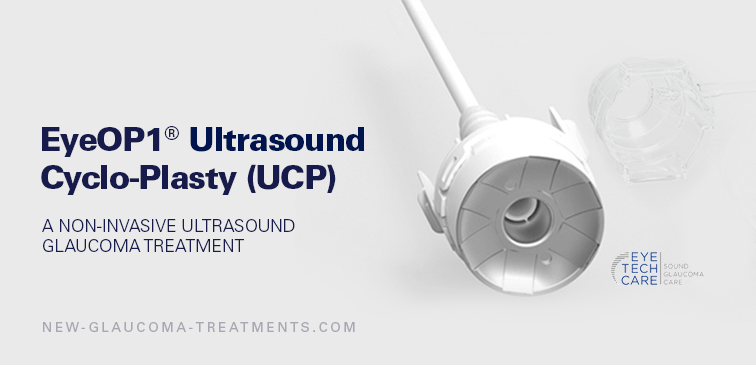
EyeOP1® Ultrasound Cyclo-Plasty (UCP)
In late October it was announced that the Chinese FDA (but not yet the American FDA) had approved a new non-invasive glaucoma treatment called EyeOP1® Ultrasound Cyclo-Plasty (also known as Ultrasound Ciliary-Plasty, or UCP).
Outside of ophthalmology ultrasound has been used to treat various diseases such as tendonitis, kidney stones, and uterine fibroids.1 Within ophthalmology, ultrasound has been used for decades to image the structures of the eye as well as to remove cataracts. Using ultrasound to treat glaucoma, however, is new.
Ultrasound devices all share one characteristic: they create high frequency sound waves that are beyond the range detectable by the human ear. Diagnostic ultrasounds also measure the waves that have been reflected off tissues (this is how the image is created). Therapeutic ultrasound devices tend to create higher energy waves with the goal of altering or destroying tissue.
Video Credit: EYE TECH CARE
How Does EyeOP1® Ultrasound Cyclo-Plasty (UCP) treat Glaucoma?
Developed in France by EyeTechCare, the EyeOP1® uses high intensity focused ultrasound (HIFU) to lower IOP. It does this by focusing this energy on the ciliary body which produces the aqueous fluid within the eye. The ultrasound energy changes the structure of the ciliary body by essentially destroying a portion of it. Because less tissue is left to produce aqueous fluid, the intraocular pressure (IOP) is reduced.
How Effective is EyeOP1® Ultrasound Cyclo-Plasty (UCP) in the treatment of Glaucoma?
EyeTechCare Funded Study of EyeOP1® Ultrasound Cyclo-Plasty (UCP)
As with many new glaucoma procedures, the first to try it are often those who have failed accepted methods of IOP control. However, what most patients with glaucoma who are initially facing surgery want to know is, “Will newer, less invasive surgeries benefit me?”
In November 2015 the results were published of a small study attempting to answer this question.2 Thirty patients with glaucoma but without prior incisional surgery underwent EyeOP1® UCP. By one year out the average IOP was reduced by 30% compared to before UCP. There was, however, no clinically significant reduction in number of medications needed to control the IOP.
It should be noted that this study was funded by EyeTechCare, the maker of the EyeOP1®. Given that EyeTechCare stands to profit from positive clinical results, the findings of this study need to be replicated by an independent group of researchers.
Study of EyeOP1® Ultrasound Cyclo-Plasty (UCP) in non-Caucasion Patients
A poster was presented at the World Glaucoma Conference 2017 which evaluated the effect of EyeOP1® UCP on 75 Indian patients with open angle glaucoma. In this study over three quarters of those who had EyeOP1® UCP responded to the treatment. Of those who experienced a successful treatment, the IOP was reduced (on average) by 40%.
What are the Risks of EyeOP1® Ultrasound Cyclo-Plasty (UCP)?
The most common “risk” of EyeOP1® UCP appears to be that it might not work. Roughly 25-30% of those who undergo this procedure just don’t respond to it. Mild to moderate discomfort during and after the procedure were also commonly encountered with EyeOP1® UCP. Additionally, roughly one third of patients may still have some residual inflammation a month after surgery. Increased astigmatism (requiring new spectacle correction) was also occasionally noted after EyeOP1® UCP.
Unlike more traditional forms of cyclodestructive therapy (such as cyclophotocoagulation) EyeOP1® UCP appears to be less likely to result in IOP spikes or hypotony (an IOP that is too low), both of which can lead to permanent loss of vision. Although some patients have been noted to lose vision after EyeOP1® UCP, for the most part such patients have either had advanced glaucoma (which tends to progress even with treatment) or cataracts (which naturally progress over time).
When is it Appropriate to Consider EyeOP1® Ultrasound Cyclo-Plasty (UCP)?
Assuming one lives in (or is willing to travel to) France or China, EyeOP1® UCP appears to be a reasonable option for those with medically uncontrolled glaucoma (that is glaucoma which is not responding to eye drop therapy). Additionally, it seems to work in both those who have never had prior surgery as well as those who have already undergone trabeculectomy. However, most of the studies performed to date indicate that the final IOP after EyeOP1® UCP will likely be in the mid-teens. As such, if one’s “target IOP” is closer to 10mmHg or below, this procedure does not appear likely (on its own) to achieve such a goal.
Summary of Ultrasound EyeOP1® Cyclo-Plasty (UCP) as a Treatment of Glaucoma
EyeOP1® UCP appears to be another step-wise improvement of the broader glaucoma treatment category of cyclodestructive procedures. Importantly, the risks of EyeOP1® UCP are notably less worrisome compared to earlier methods of ciliary body alteration. Although not without risk, EyeOP1® UCP may be the lowest risk “cyclo-” glaucoma treatment to date. If future clinical studies continue to support the IOP lowering benefit paired with minimal risk then I am hopeful that the US FDA will follow France’s and China’s lead in approving the EyeOP1® UCP as a glaucoma treatment.
Related Articles:
References:
-
Miller D, Smith N, Bailey M, et al. Overview of Therapeutic Ultrasound Applications and Safety Considerations. Journal of ultrasound in medicine : official journal of the American Institute of Ultrasound in Medicine. 2012;31(4):623-634.
-
Aptel, F., Denis, P., Rouland, J.-F., Renard, J.-P. and Bron, A. (2016), Multicenter clinical trial of high-intensity focused ultrasound treatment in glaucoma patients without previous filtering surgery. Acta Ophthalmol, 94: e268–e277. doi:10.1111/aos.12913

David Richardson, MD
Medical Director, San Marino Eye
David Richardson, M.D. is recognized as one of the top cataract and glaucoma surgeons in the US and is among an elite group of glaucoma surgeons in the country performing the highly specialized canaloplasty procedure. Morever, Dr. Richardson is one of only a few surgeons in the greater Los Angeles area that performs MicroPulse P3™ "Cyclophotocoagulation" (MP3) glaucoma laser surgery. Dr. Richardson graduated Magna Cum Laude from the University of Southern California and earned his Medical Degree from Harvard Medical School. He completed his ophthalmology residency at the LAC+USC Medical Center/ Doheny Eye Institute. Dr. Richardson is also an Ambassador of Glaucoma Research Foundation.
Looking for an Ophthalmologist in California?
Dr. David Richardson is taking new patients at his office in San Marino, CA., and is always willing to provide a second opinion for those who would like the peace-of-mind that such a consultation would provide.


